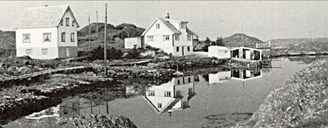White-painted church with a low steeple
In 1718, Husøy became the new church site for the chapel at Utvær. Husøy is a small island a little to the west of Ytre Sula. There they had a small, white-painted church with a low steeple above the western gable wall. The nave itself measured 7.5 by 6.3 metres (about 25 by 21 feet) and had room for 120 persons. The size of this church is more or less identical to the measurements of the Utvær chapel, and it might be correct to assume that the old wooden church was moved to the new church site instead of building a new one. The steeple and the porch were both tarred. On the southern nave wall there were two square windows and one on the chancel wall, whereas the northern nave wall of the chapel had one window, in addition to a window and a door in the chancel wall. A vestry was added to the chancel on the south side, and there was also a small gallery at the western end.
Losing his right of ownership
During an inspection tour in 1755, the bailiff Annanias Christopher Harberg, who owned the church at that time, along with the seven members of the dispatched court of appeal, could see for themselves that the chapel had already begun to rot from the ground. Even worse off was the graveyard where there actually was not enough soil to cover the coffins. It became clear that the church had to be moved, but nobody took any responsibility. Only in 1787, after the then church owner had lost his property right, did work get underway to repair the derelict chapel. The curate Jacob Barkmann Dresing took charge of the salvage operation and the chapel could be used for another hundred years.
The "sokn" church moved
In the meantime, the "sokn" congregation had increased to 500 persons. Husøy became a ¿sokn" in its own right, and people felt that the time was ripe for a new church. By and by there were more people living east of the Straumfjorden than on the smallest islands to the west. The church had become too small, and repair work was drastically needed. Another argument for moving the church was to find a less weather-exposed site. Besides, a better churchyard was needed. The islanders stood their ground, wanting the church to be rebuilt on the same site. They were opposed by the vicar Kvaale and the Norwegian Ministry of Church Affairs. The church was eventually moved, but this heated location disagreement also split the congregation. In protest the islanders contributed neither duty work nor money when the construction work was started at Straumen in the spring of 1896.
Dismantled and reassembled at Lindås
At the same time as the new church was completed, the islanders sent an application to the Ministry of Church Affairs, asking to keep their church as it was, and also to be allowed to hold a few services there every year. If their application was turned down, they would all renounce their membership in the state church. The matter was taken up for discussion by the ¿sokn" council and the municipal council. The mayor, Johs. K. Lågøy, cut the Gordian knot by deciding that the best solution would be to tear down the chapel, sell it, and let the whole ¿sokn" benefit from the sale. And this is precisely how the matter was settled.
The chapel was sold in 1897 and reassembled four years later as a combined "bedehus" and chapel at Leirvåg in the municipality of Lindås, Hordaland. This house has seen some additions and changes over the years, but still has a main hall which largely consists of building material from the old church. There might even be some timber in the house from what was once the chapel at Utvær. In this way ends the story of the churches at Utvær and Husøy. A few persons felt so much anger and grief at losing their church that they made good their threats of leaving the state church.
Art and interior
The altarpiece from the 1600s is carved in pine with a high relief. Formerly the altarpiece was thought to come from Eivindvik church, but it has now been established to come from Solund. If this is the case, it must first have been used in the chapel at Utvær and later on at Husøy, too. A new altarpiece was taken into use in 1724. Some people have believed that the three persons on the painting must be Jacob, Esau, and Isaac, their father, whereas others think the painting probably depicts Job with two of his three friends. When Job was struck with one calamity after the other and he lost everything, ¿¿ he took him a potsherd to scrape himself withal; and he sat down among the ashes". (Job 2;8).
The church bell from 1641 is made of bronze with the inscription: "Sidevs Valqvor Brodersen gives (?) this bell: Pronobis qvis contra nos anno 1641". This bell was first used in the church at Utvær and later on in the church at Husøy, but was never taken to the new church at Straumen.
Two carved figures, probably dating from the period 1772-1790. The figures may have adorned the church, but we know that for a period of 100 years they were privately owned and used as wall decoration in a house. As objects of church art they seem to us sensational and daring. One figure shows a woman holding up her own breasts. At certain times the church has been portrayed as a woman breast-feeding her newborn and helpless children.
The art objects referred to above are now placed at ¿De Heibergske Samlinger - Sogn Folkemuseum" at Kaupanger in Sogndal.



